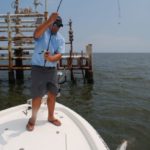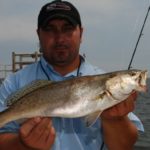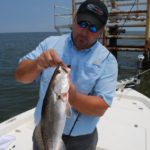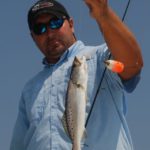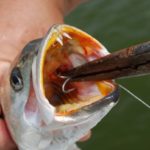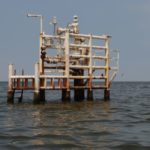
Just because the tides aren’t rolling doesn’t mean trout won’t bite. Here are some tips on how to put fish in the boat, even on wimpy tides.
The broad-chested guy sitting in the driver’s seat of the big Ford pick-up cleared his throat, as if preparing to speak. I glanced over at him. In the dark, the glow from the truck’s dash lights made his chiseled features appear even sharper.
“We sure picked a bad day,” he said quietly, as if preparing me for the worst. “The tide is really rough.
“We have only a .08 (foot) tide range — not a .8, but a .08. I don’t know if I’ve ever fished anything less than a .1 before.”
“But,” I thought to myself, “Brandon Carter can overcome that. He’s a famous speckled trout guide.”
Susan Gros, a long-time friend and one-time world-class angler and record chaser, called him a “trout-fishing fool,” adding “I have caught some of my biggest fish with him.”
Then the day became even more inauspicious when Carter backed his bay boat down the ramp at the Venice Marina. The trim wasn’t working. The motor kicked up violently every time he threw it into reverse and wouldn’t settle into running position until he jammed down hard in forward.
So up the road we went to his mechanic in Port Sulphur to wait for his shop to open. He confirmed our problems. The hydraulic ram was out.
We could scrub the trip, or we could fish from a crippled boat — on a wimp tide — with an hours-late start. Sanity aside, we opted for the later, and 10:30 a.m. found us gingerly backing down the ramp at the marina.
It felt good to finally be on the water.
As we headed across the Mississippi River to Baptiste Collette, Carter’s grim look melted a little.
“It feels weird to be heading this way in the daylight,” he said. “I’m usually headed this way in the dark.”
Breton Sound, our target, is not often thought of as a Venice destination but rather a St. Bernard Parish one. But Venice is actually a shorter run.
Carter was heading there because he wanted to focus on areas that would concentrate what current there was, a tough thing to do in mid-summer when speckled trout are still outside, in more open waters.
The platforms, large and small, that we planned to hit were located in a sort of funnel between the tip of the Chandeleur Island chain (Breton Island) and the land mass of the Mississippi River delta. The first stop was at a small well guard north of the track between Baptiste Collette and Breton Island.
Carter opened the livewell and scooped out a net full of popping shrimp. He fixed his piercing blue-green eyes on me and matter-of-factly stated that using live bait is a way to help beat the odds on a wimp-tide day.
After impaling one prong of a treble hook under a shrimp’s horn, he combed the limestone shell pad around the wellhead with his bait, rather than just casting close to the well.
“Lots of times,” he explained, “trout are scattered all around the pad and even on its edges.”
His rig was simple and one that he used most of the day: a Carolina rig with a ¼-ounce egg sinker threaded on his main line, then a black barrel swivel, followed by an 18-inch 30-pound-test mono leader and a No. 4 treble hook.
He always uses treble hooks because he believes he gets more hook-ups, but Carter did admit that they don’t have the “holding power” of single hooks.
“What good is holding power, if you miss the strike?” was Carter’s logic.
The shrimp wasn’t allowed to sit still; instead, after it hit bottom, it was slowly brought in with a bumping retrieve and then cast again. Carter bounces the bait off the bottom because he said trout aren’t bottom feeders.
“Their mouth is turned up, not down like a redfish,” he said. “They suck things off the bottom.”
Brandon Carter has very little regard for a redfish.
Carter worked his trolling motor standing up rather than dropping his anchor, the pattern for most the day. The live shrimp produced bites, but from hardhead catfish.
After catching several of the pests, however, he slammed the hook home and a speckled trout came thrashing to the surface — a good one about 4 pounds.
He started to flip it into the boat, hesitated and moved to the landing net. Just like that, the hook pulled free and the fish was gone.
What if …?
Next up was what he deemed to be a jack, which he promptly broke off. The next bite produced a redfish, which upon identification was also broken off. “
“When I am looking for trout,” he growled, “I’m not going to waste time with these fish.”
He picked up three specks, all over 2 ½ pounds, and then moved to another nearby well guard to repeat his performance.
“That’s a strategy on a weak tide,” he said. “Pick off the 3, 4, 5 fish that are most actively feeding, and then keep moving until you get your box.
“And you have to stay on your toes. You may only get 30 bites versus 150 on a day with good tides. Every bite counts on these days.”
Three more good trout ended up flopping on the deck from this spot before the mini-bite played out.
A move to another well yielded two specks. Not many were coming out of each spot, but they were all over 2 pounds — good fish by any standards.
The next well guard didn’t produce a bite, but he stoically probed the whole pad around the well, noting that a fisherman must be more patient on poor tide days because the fish are less aggressive and harder to get feeding.
Changing tactics, Carter cradled his trolling motor and moved due south to a big platform set in 22 feet of water. Following his normal practice, he killed the big motor out a hundred or so yards out and trolled in.
“On deeper rigs such as this,” he said while easing in, “I normally fish up inside the rig, unless I know of a trash pile or something outside of it to fish.”
Riding his trolling motor the whole time, he kept close enough to the platform to pitch in to almost any point. While he fished, he provided more coaching about fishing successfully on wimp tides.
“On days with low tide ranges, you need to plan so that you are on your best spots at the best times of the day,” he said. “In hot weather (like now), that means early in the morning — the first hour.”
Hmmm, I thought about our 10:30 a.m. start.
Also, he added, be sure to be fishing during the peak flows, when what tide there is will be running strongest — the middle of the tide.
In contrast, on a very strong tide, a fisherman should plan to be on his best spots when the tide is switching — at its slackest point.
“When a tide is too strong,” which he defined as 2 feet or more, “the fish shut it down and just hold their positions.”
The easiest-to-fish tides, according to Carter, are those with ranges of .7 to 1.4 feet.
The subject of patience came up, and the hard-driving fisherman had opinions about, that as well.
“When tide flow is good and the fish are there, they will be feeding, so if I don’t get a bite, I leave pretty quickly,” he said. “But on small tide ranges, be more patient.”
He worked the trolling motor hard to be able to cast into every spot beneath the big concrete-legged platform. He explained that he uses his trolling motor a lot to look for fish, but if he is confident of finding fish or finds a concentration of them, he will drop anchor.
Anchoring is also the rule for Carter in the winter, when he is fishing in the spillways coming off of the river’s passes, where the current is strong and the fish are on humps or drop-offs.
Not a yellowmouth accepted Carters offerings. Four banana fish and a sheepshead later, he murmured “Let’s make a move.”
Next stop was a set of four yellow-legged, spider-like rigs connected to each other.
Here, he couldn’t even hook a hardhead, much less even a banana fish or redfish. And he worked it hard.
“This rig is devoid of life,” grumbled Carter.
The young guide was indeed practicing what he preached — patience.
He ran farther south, outside the Chandeleur Islands and into federal waters — Breton Sound Block 53-A to be exact. At this complex of three big rigs, Carter tied off to start fishing rather than use his trolling motor.
Almost as if explaining to himself as much as me, Carter counseled, “On bad tides, don’t give up too quickly; you have to understand that you are not going to slam them. Be methodical.”
Methodical and patient he was, first from his tied off position and later as he moved the boat around the platform. The banana fish put on quite a show. It was one after the other. And it was easy to see why ladyfish (their more proper name) are the closest living relatives of tarpon.
Like their big cousins, once hooked, they spend as much time in the air as in the water, and in their leaps they stretch their jaws wide open and arch their heads back over their body.
But they weren’t speckled trout.
Carter sighed and headed north to Breton Island to finish the day. He suspected he could catch lots of fish in the cove of the island, but feared that they would be small.
As he was idling into the interior of the island, he traded his Carolina-rigged casting rod for a spinning rod holding a popping cork over a treble hook. Spinning reels make the job of casting a cork-rigged line much easier, especially if any wind is present.
The interior cove of the crescent-shaped island was protected from the wind, and the water was beautiful. A mob of brown pelicans festooned the beat-up old wooden bulkhead that, along with a concrete slab and an abandoned wellhead, is all that is left of man’s presence on a once-substantial island.
He moved the boat to the upwind side of the cove and began casting as the boat drifted. He nudged the trolling motor occasionally, both to hold it in position for a second cast into a spot where he got a bite and to keep the boat turned to the angle he wanted.
“This is mostly going to be schoolie trout,” he explained. “It’s hard to beat a shrimp under a cork for them.
“It’s worked for a hundred years, and it will work for another hundred years.”
He worked the cork with a slow, methodical popping motion. As he predicted, the catch were mostly 12- to 15-inch fish. Carter wasn’t happy about the size, but what the heck — they were speckled trout.
He drifted across the cove until he felt he was out of the fish, circled back around and drifted from a slightly different spot. Each time, he memorized the small spots that seemed to produce fish. In what looked like utterly featureless terrain, the fish definitely held to those spots, and repeated casts into them produced fish while others didn’t, drift after drift.
“This is what you do to finish the day on a rough day,” he said. “Go back and forth, hammering the best spots to make your catch. You’re not killing them, but you milk the area for every fish it will give up.”
On the way in, Carter seemed noticeably cheerier, even though he had to complete his catch with small fish. He looked at me and grinned.
“One more piece of advice: On bad tide days, don’t just stay home and not fish,” he said. “You can’t kill them on the couch.”
Capt. Brandon Carter is a featured angler in the newly printed book Trout Masters Too: How the Pros Do It now available online at www.shop.lasmag.com. Carter’s business, Reel Shot Guide Service, may be contacted at 985-969-0810.
